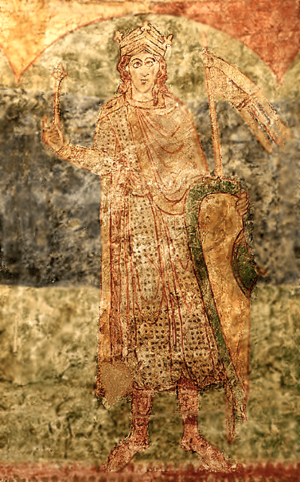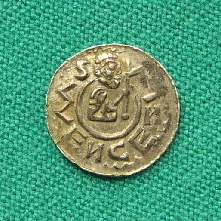Vratislaus II of Bohemia facts for kids
Quick facts for kids Vratislaus II |
|
|---|---|
 |
|
| Duke of Bohemia | |
| Reign | January 1061 – June 1085 |
| Predecessor | Spytihněv II of Bohemia |
| Successor | himself as king |
| King of Bohemia | |
| Reign | June 1085 – 14 January 1092 |
| Coronation | 15 June 1085, Prague |
| Predecessor | himself as duke |
| Successor | Conrad I of Bohemia |
| Born | c. 1032 |
| Died | 14 January 1092 (aged c. 59–60) |
| Burial | Vyšehrad |
| Spouse | Maria Adelaide of Hungary Świętosława of Poland |
| Issue | |
| Dynasty | Přemyslid |
| Father | Bretislaus I of Bohemia |
| Mother | Judith of Schweinfurt |
Vratislaus II (also known as Wratislaus II) was born around 1032. He was the son of Bretislaus I of Bohemia and Judith of Schweinfurt. Vratislaus became the first King of Bohemia on June 15, 1085.
This special title was given to him for life by the Holy Roman Emperor, Henry IV. It meant he was a king, but his children would not automatically become kings after him. Before becoming king, Vratislaus ruled Bohemia as its Duke starting in 1061.
Contents
Becoming a Ruler
When his father died in 1055, Vratislaus became the Duke of Olomouc. His older brother, Spytihněv II, became the main Duke of Bohemia.
A Duke's Early Challenges
Vratislaus had a disagreement with his brother and was sent away to Hungary. With help from Hungary, Vratislaus got his ducal throne in Olomouc back.
Later, he and his brother made up. When his brother died in 1061, Vratislaus became the Duke of Bohemia.
Supporting the Emperor
Vratislaus was allowed to wear a special hat (mitre) and robe (tunic) by the Popes. This was a privilege his family had for a long time.
Despite this, Vratislaus supported Emperor Henry IV in his big arguments with the Popes. He also helped Henry IV against rebellions in a region called Saxony.
Vratislaus often had problems with his brother, Jaromír, who was the Bishop of Prague. Jaromír didn't like it when Vratislaus created a new church area (diocese) in Olomouc in 1063. Jaromír even used soldiers to take back holy items that had been moved from Prague to Moravia. Even with the Pope supporting Vratislaus's new church area, Vratislaus stayed loyal to the Emperor.
Battles and Loyalty
In 1070, people in Saxony rebelled against Emperor Henry IV. Also, the King of Poland attacked Bohemia in 1071. Henry IV fought back, and Vratislaus joined him.
In 1075, they defeated the rebels in a big battle called the First Battle of Langensalza. The Bohemian soldiers were very brave in this fight. After this, Henry IV took Jaromír, Vratislaus's troublesome brother, to Germany to be his chancellor. This made Vratislaus very happy.
Vratislaus also helped Henry IV fight against other rulers who tried to take Henry's place as Emperor. In one battle, the Battle of Flarchheim, Vratislaus's soldiers were key to Henry's victory. Vratislaus even captured a golden spear from one of the enemy leaders. This golden spear was then carried in front of Vratislaus on important occasions.
Vratislaus helped defeat rebels again in 1082. Because of his strong loyalty and help in these victories, Emperor Henry IV made Vratislaus a king in 1085.
Working with the Pope
In 1080, Vratislaus asked the Pope if he could use a special Slavonic language in church services. The Pope said no. He might have asked this to help a Slavonic monastery near Prague that was still using that language.
Vratislaus also sent his army to help Emperor Henry IV in Italy in 1081. In 1083, Vratislaus and his Bohemian soldiers were with Henry when they marched into the city of Rome itself.
Expanding Bohemia's Power
Vratislaus wanted to control the lands of Meissen and Lusatia, which were mostly Slavic. Even though Emperor Henry IV promised him these lands and Vratislaus's soldiers won battles there, he never fully received them.
He held Lower Lusatia for a while, but in 1088, Henry IV gave the region to someone else. After this, Vratislaus was less eager to help Henry IV in his military adventures. He remained loyal but stopped sending his army to help the Emperor.
Family Matters and Challenges
It was a tradition in the Přemyslid dynasty that younger brothers of the ruler would govern parts of Moravia. Vratislaus's younger brothers, Conrad and Otto, received lands in Brno and Olomouc. His youngest brother, Jaromír, became a church leader.
Family Conflicts
However, problems grew between the brothers. Vratislaus created the diocese of Olmütz (now Olomouc) to reduce Otto's power in his area. Both the Pope and the Emperor tried to help solve these family fights.
In 1077, Emperor Henry IV made Jaromír his chancellor, which helped calm things down a bit. Later, in 1085, a big meeting in Mainz tried to close the Moravian church area, but Vratislaus reopened it. Jaromír complained to the Pope, but he died in 1090 before the Pope could decide.
Sadly, Vratislaus's last years were filled with arguments within his own family. When his brother Otto died in 1086, Vratislaus gave Olomouc to his son Boleslaus. This upset Conrad, who felt it was against his rights.
Vratislaus sent an army against Conrad, led by his other son, Bretislaus. But this son turned against him! Following Bohemian custom, Vratislaus named Conrad as his heir. Then, Vratislaus and Conrad teamed up and attacked Bretislaus, who had to flee to Hungary.
Vratislaus died on January 14, 1092, from a hunting injury. He had ruled for thirty years. He was buried in St. Peter and Paul's Church in Vyšehrad.
Vratislaus's Lasting Impact
Vratislaus often disagreed with Jaromír, Bishop of Prague. He tried to make the Bishop of Prague less powerful in Bohemian politics. He did this by reopening the Bishopric of Olomouc in 1063. He also created the Vyšehrad Chapter in 1070. This new church group had a lot of money and answered directly to the Pope, not the Bishop of Prague.
His success in limiting the power of the Prague bishop helped make the Bohemian crown stronger. This allowed later rulers to govern a more united country. His way of dealing with the Holy Roman Empire set an example for future rulers. This eventually led to Bohemia becoming a permanent kingdom in the early 1200s.
Vratislaus also arranged marriages for his children with important foreign princesses. This showed that the Přemyslid family was becoming more important among European royal families. In contrast, Vratislaus's father had to kidnap his wife to find a suitable partner. Vratislaus's children continued to make strong family ties with other royal courts in Europe.
His Family
Vratislaus was married three times. His first wife, Maria, died during childbirth.
He married his second wife, Adelaide, in 1057. She was the daughter of Andrew I of Hungary. Adelaide died in 1061. They had these children:
- Vratislaus (died 1061)
- Judith (born 1056/58, died 1086), who married Ladislaus I Herman
- Ludmila (died after 1100)
- Bretislaus II of Bohemia (born around 1060, died 1100), who became Duke of Bohemia
In 1062, Vratislaus married for a third time to Swatawa of Poland. She was a daughter of Casimir I of Poland. They had five children:
- Boleslaus (died 1091)
- Bořivoj II of Bohemia (born around 1064, died 1124), who became Duke of Bohemia
- Vladislaus I of Bohemia (died 1125), who became Duke of Bohemia
- Soběslav I of Bohemia (died 1140), who became Duke of Bohemia
- Judith (born around 1066, died 1108), who married Wiprecht II of Groitzsch


